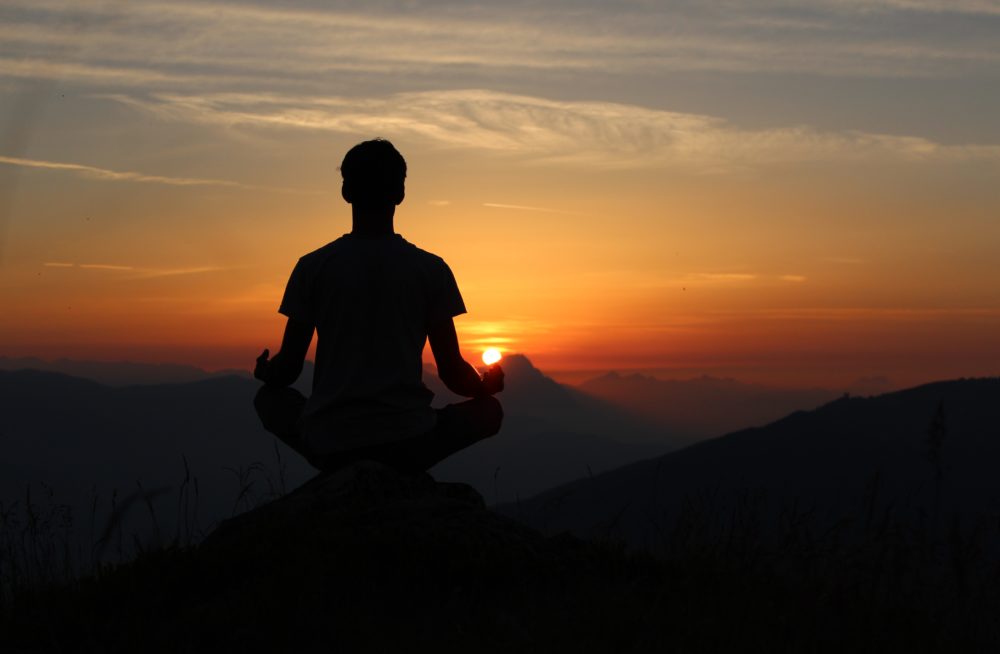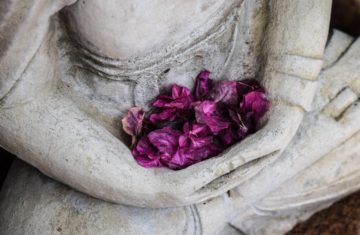Happy New Year! It seems so fitting that practicing the fifth paramita, meditation, is happening in January. January brings the feeling of new things, of fresh starts. It is the perfect time to begin a meditation practice, if you don’t have one already. Or, to just give meditation a try.
The Sanskrit word dhyana means concentration. Most people describe it by using the word meditation though, because the kind of concentration it’s asking of us is the kind that brings awareness and enlightenment. That being said, we don’t want to get too far ahead of ourselves.
I really like Lama Surya Das’ simple and clear definition of meditation. He says it is “the intentional use of attention as applied to this very moment.” Notice that he doesn’t say it doesn’t count if you didn’t reach enlightenment or some life-altering breakthrough of clarity. First and foremost, it’s just about showing up and paying attention.
Meditation is indeed potent and powerful, and it’s at the root of our awakened presence in the world. But before we can show up and pay attention to the world at large, we have to practice showing up and paying attention to our own minds. And… it tends to be crazy in there.
We are not alone in this. But we don’t have to stay in it, either.
In Buddhism, there is a name for people who live in a state of confused, busy, unstable mind: samsara. Samsara in Sanskrit means “wandering around.” That hits home for me, because my mind’s very favorite thing in the entire world is to wander around. My mind is often like Penn Station, with dozens of trains coming and going in all directions. When I was first learning to meditate, I remember being incredulous at the idea that sitting still and breathing was somehow going to magically make the train station quiet. I can’t say it’s ever library-level quiet in there, but you wouldn’t believe the improvement in noise pollution. So the good news is that meditation absolutely can calm your mind. The bad news is that if my noisy mind can learn to be stable, yours definitely can.
Samsara also suggests an image of those times you’re aimlessly roaming around your home or office trying to figure out what it was you were going to do, but you can’t remember. This an appropriate GIF for everyone living a busy, modern life. We are so bombarded with tasks and information and requests that it’s only natural for our brain to reject all of that noise and space out from time to time. Next time that happens to you, rather than judging yourself for being forgetful, consider that your brain might be asking for a brief little vacation. And then give it one.
I know I don’t need to spend much time convincing you that your mind could stand to become a little more stable. If there’s any frustration or complaint I hear the most from friends, colleagues, and fellow parents, it’s how overwhelmed we feel, how we wish we could slow down, how tired we are of feeling busy and stressed and tired. The very best way to remedy this is meditation. You can’t hope a calm mind into existence; you’re going to have to practice it.
And January is a perfect month to give it a go. So here’s a very reasonable goal: can you commit to meditating for five minutes, three times a week for the month of January? (Yes, you can.) If you want more of a challenge, make it your goal to meditate every day- whether it’s for five minutes or twenty. Get in the habit of giving your mind some space, and practicing awareness and attention.
And, while you can find a long list of helpful articles about how to meditate, here’s a quick beginner’s guide. You don’t need anything but a pillow or a chair, and a timer. For a timer, use your smartphone. (I use the Insight Timer app and love it.)
A Brief Introduction to Basic Meditation
1. Find a comfortable sitting position. If you are in a chair, scoot up to the front so that your feet are firmly planted on the ground and your back is not leaning against the back of the chair. If you’re on the floor, it’s best to have your hips above your knees, so sitting on a pillow works well.
2. Keep your eyes open. Find a spot a few feet in front of you—not too far out, but not so close that it strains your eyes or arches your neck. It should feel very natural. Let your gaze go soft. You’re not glaring at the spot you chose, you’re just letting your eyes relax in that general direction.
3. Rest your hands palms down on your knees. If you’re anything like me, you’ll need to check every so often to make sure you are not clamping down with a death grip. Your body should be relaxed, while your back is straight and strong.
4. Set a timer for however many minutes you’d like, and push start. Focus on your breathing. Just listen and feel it going in and out. You’ll soon notice your thoughts whizzing past like fast pitches, or maybe a dripping faucet. Just let them go right on by. The goal isn’t to stop thinking thoughts. It’s about not holding onto them or getting stuck with them. Some people like to label their thoughts to help with this, which is simply the act of saying (quietly, in your mind) “thought” every time one swings (or drips) through.
5. Stick with it. Keep coming back to your breath. The breath can ground us if we just give it the space to slow down and bring us back to our essential nature. There’s calmness in there, waiting to be rediscovered over and over again.
If you do set a meditation goal for January, I wish you all the heroic perseverance you need to complete it fully. And stay tuned for further articles on dhyana in the weeks to come.
This post is part of the Paramita Project. You can learn more about it here.




